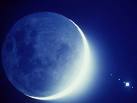A blue moon is a full moon that is not timed to the regular monthly pattern of the moon phases. Almost all the years have twelve full moons which occur on a monthly basis, but in addition to those twelve full lunar cycles, each calendar year contains an excess of roughly eleven days. The extra days accumulate, so that every two or three years, there is an extra full moon. This extra moon is called a "blue moon."

Most years have twelve full moons, which occur once in each month, but the cycle doesn't take a complete year and there is about eleven days left over. The extra days accumulate, so that every two or three years there is a thirteenth extra full moon which is known as a "blue moon."
The year 2009 ends with two full moon's in December with the blue moon on New Year's Eve. The blue moon will be partially eclipsed with the moon entering the Earth's shadow at 18.51, with the greatest shadow at 19.22 and ending at 19.53.
Sometimes the Moon appears to be bluish in color when the atmosphere contains smoke and dust from huge forest fires or volcanic eruptions. If the particles in the atmosphere are of the right size, the red light with longer wavelengths is scattered out of the line of sight and the shorter wavelengths, which appear blue are seen by the observer. Hence the name.
The next such blue Moon is scheduled to be sighted on August 31, 2012 and the previous one occurred in June 30, 2007. The specialty of this blue Moon is that it coincides with a parital lunar eclipse.